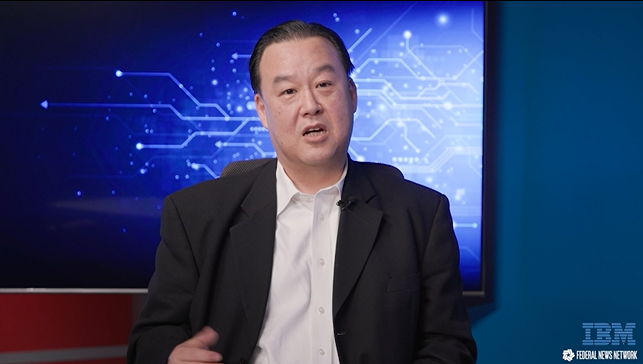This vendor tested its AI solutions on itself

As its own ‘client zero’, IBM identified its human resources function back in 2017 for transformation with artificial intelligence. Today, the function is fully automated, and IBM has a wealth of insights and learnings to share that they hope can help federal agencies avoid some of the same pitfalls.
IBM took an AI-driven approach to transforming its HR function. For its test bed, the company used itself and came away with valuable lessons learned.
Now IBM can help federal agencies apply those lessons and — hopefully — avoid some of the same mistakes. That’s according to Mike Chon, IBM’s vice president and senior partner of talent transformation for the U.S. federal market.
“IBM has gained the efficiencies, it’s delivered on the employee experience, it has achieved a lot of the automations [and] productivity gains,” Chon said.
He cited statistics that tell the story. IBM employees have had nearly two million HR conversations with a virtual agent. Those have achieved resolution in 94% of the cases, meaning the employee didn’t need to proceed to a conversation with a live person.
Manager productivity
When seeking HR efficiencies, organizations tend to think initially in terms of self-service for employees. But Chon urged IT and HR staffs to think more broadly to include managers too.
“I also want to emphasize manager self-service,” he said. “I think that’s where the additional value can come in.”
It also requires a bit of rewiring of manager habits. Chon said that initially, he, like many experienced managers, was less inclined to invoke a chatbot than to simply call his HR representative with questions.
“I myself did not really adopt that [AI] paradigm right away,” he said. “My muscle memory was to call an HR person. Clock forward to today … I actually tend to go to our AI chatbot more than an HR manager.”
He added, IBM managerial uptake of the HR chatbot has reached 96% worldwide, accounting for 93% of the transactions.
HR presents a natural entry point for AI because it touches everyone.
“By introducing AI through HR, you’re really having this ability to embed the use of these tools throughout your enterprise,” Chon said. “I think that really starts to get people more comfortable.”
Use case approach
Having chosen the HR function, Chon said, IBM initially tried an overly comprehensive approach.
“When we first started this journey, we tried to boil the ocean. It was this big bang approach,” Chon said.
The company realized almost immediately that the tool wasn’t quite right, and people weren’t embracing it.
Lesson learned?
“Never seek the silver bullet,” Chon said. “It really forced everyone to put the brakes on this process” and rethink their approach.
The rethinking resulted in what Chon called a building block, use case-by-use case approach. The team started by identifying specific high-frequency or highly repetitive tasks, the automation of which would allow the team to spend less time on routine tasks and more on strategic, value add work. Data connected to each task helped with this identification, which ultimately allowed the team to identify two use cases: employee time off and proof-of-employment letters. Before AI, employees would ask their HR representative how many vacation days they had left, and it could take days for HR to prepare and send employee proof of employment letters, Chon said. These tasks represented some of the most repetitive and time consuming for the function.
“AI gave employees the ability to find out their vacation days in seconds and generate their own employee verification letter from anywhere, anytime. And they get instant satisfaction because it happens right in front of them,” Chon said.
In the employment verification letter use case, AI took the form of robotic process automation, he added.
Moreover, if a particular step to a task doesn’t work, HR and IT could simply turn it off and improve it, without affecting everything else that’s working well.
It’s also important to understand that in a small percentage of cases, employees will need to interact with humans; no AI agent can do everything. Therefore, Chon said, “we always give people the ability to connect to a live agent.” Careful data analysis of what leads to “off-ramps” helps with continuous improvement of the AI tool, he said.
Ultimately, Chon said, the HR AI-driven self-service option for employees and managers lets HR professionals become more productive, taking the drudgery out of HR processes, leaving people more time for “tackling things like recruiting and other high value activities like talent development.”
Ultimately, the key lessons learned from IBM’s experience center on employing a use-case driven approach. AI is successfully adopted with small wins, building blocks and steps. Larger, more strategic and transformational use cases don’t have one clear answer or outcome. The key is finding a use case — a workflow, process or task — that could be accelerated or improved through automation. This also allows for easier scaling to other parts of the agency.
“Now, I would say, seven years later, each time the team launches a new use case, it’s actually getting better and better,” Chon said.
Listen to the full show:
<""""""""""""><><><><><><><><><><><><><><><>
The post This vendor tested its AI solutions on itself first appeared on Federal News Network.
Welcome to Billionaire Club Co LLC, your gateway to a brand-new social media experience! Sign up today and dive into over 10,000 fresh daily articles and videos curated just for your enjoyment. Enjoy the ad free experience, unlimited content interactions, and get that coveted blue check verification—all for just $1 a month!
Account Frozen
Your account is frozen. You can still view content but cannot interact with it.
Please go to your settings to update your account status.
Open Profile Settings